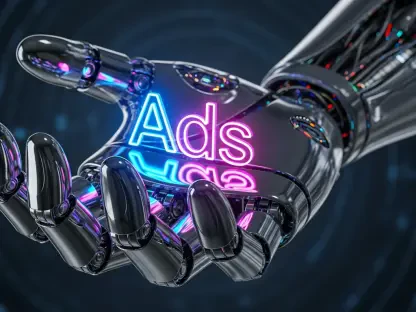In an era where digital transformation dictates the pace of business, generative AI has emerged as a game-changer in marketing, with over 73% of marketers already leveraging this technology for content and strategy. This staggering adoption rate signals a shift in how campaigns are crafted and consumers are engaged, promising efficiency and personalization at unprecedented levels. This review dives deep into the capabilities of generative AI, examining its role in reshaping marketing landscapes through automation, data insights, and creative output, while also addressing the hurdles it faces in widespread implementation.
Understanding Generative AI in Marketing
Generative AI stands as a revolutionary force in marketing, utilizing advanced machine learning models to produce text, images, and multimedia content from vast data inputs. Unlike traditional tools, this technology can autonomously generate ad copy, design visuals, and even simulate consumer interactions, fundamentally altering the creative process. Its rise, fueled by platforms like ChatGPT and Midjourney, addresses the growing demand for speed and customization in campaign development.
The relevance of generative AI extends to its ability to automate repetitive tasks, tailor customer experiences, and predict market trends with remarkable precision. Integration with search engines and social media platforms amplifies its impact, enabling marketers to optimize content for visibility and engagement across digital ecosystems. This synergy with existing technologies positions generative AI as an indispensable asset in modern marketing arsenals.
Beyond automation, the technology reflects a broader shift toward data-driven decision-making in the industry. As businesses strive to meet consumer expectations for personalized interactions, generative AI offers tools to analyze behaviors and craft targeted strategies in real time. Its emergence marks a pivotal moment, redefining efficiency and creativity in equal measure.
Core Features and Capabilities of Generative AI
Content Creation and Ideation
Generative AI excels in content creation, empowering marketers to produce high-quality text, visuals, and multimedia with minimal human input. Tools like DALL-E and ChatGPT can generate blog posts, social media graphics, and video scripts in a fraction of the time traditional methods require. This capability not only saves hours in ideation but also ensures output consistency, making it a vital resource for teams under tight deadlines.
The significance of this feature lies in its democratization of creative skills, allowing non-specialists to engage in design and copywriting with professional-grade results. Performance metrics highlight substantial time reductions, with some reports indicating up to 60% faster content production cycles. Such efficiency enables brands to maintain a steady flow of fresh material, crucial for staying relevant in competitive markets.
Moreover, the quality of AI-generated content often rivals that of human creators, especially in structured formats like product descriptions or ad slogans. While occasional refinements are needed for tone or brand alignment, the technology’s ability to scale output offers unmatched value. This accessibility transforms how small businesses and large enterprises alike approach content strategy.
Data Analysis and Predictive Insights
Another cornerstone of generative AI is its prowess in data analysis, slashing the time needed to evaluate campaign performance from days to mere minutes. By processing vast datasets, these systems identify patterns and deliver actionable insights, enabling marketers to fine-tune strategies on the fly. This rapid turnaround is essential for adapting to fast-changing consumer preferences.
Predictive modeling within generative AI further enhances its utility, offering forecasts on trends and behaviors with improved accuracy. Real-world applications include optimizing ad spend by pinpointing high-impact channels, with some studies showing prediction accuracy rates climbing above 80%. Such precision helps allocate budgets effectively, maximizing return on investment.
The technical depth of these tools also supports nuanced analysis, such as sentiment tracking across social platforms or predicting purchase intent based on browsing data. Businesses leveraging these insights gain a competitive edge, responding proactively to market shifts. This analytical power underscores generative AI’s role as more than just a creative tool, but a strategic one as well.
Recent Innovations and Trends in Generative AI Marketing
The marketing sphere continues to evolve with generative AI, as recent innovations like AI-driven A/B testing reshape campaign optimization. These systems can simulate multiple ad variants simultaneously, identifying top performers without extensive manual oversight. This advancement streamlines decision-making, ensuring resources focus on high-yield strategies.
Another notable trend is the integration of AI into search engines, with features like Google’s AI Overviews shifting how content is discovered. This evolution toward “answer engine optimization” compels marketers to adapt, prioritizing direct, concise information over traditional SEO tactics. The change influences how brands structure their online presence, aiming to capture attention at the query stage.
Additionally, automated campaign management tools are gaining traction, handling everything from scheduling to performance tracking with minimal input. This trend reflects a broader push toward efficiency, freeing up teams for strategic planning rather than operational minutiae. As these innovations mature, they promise to redefine interaction between marketers and digital platforms.
Real-World Applications of Generative AI in Marketing
Across industries, generative AI finds practical application, notably in retail where personalized recommendations drive sales. Platforms like Netflix utilize AI algorithms to suggest content, with similar approaches in e-commerce tailoring product suggestions to individual tastes. This hyper-personalization boosts engagement, fostering deeper customer connections.
In entertainment and social media, automated content generation powers campaigns at scale, crafting posts and visuals tailored to platform algorithms. Brands in these sectors benefit from consistent output that resonates with audiences, maintaining visibility in crowded digital spaces. The versatility of AI ensures relevance across diverse marketing goals, from brand awareness to direct conversions.
Unique deployments also emerge, such as AI chatbots streamlining customer support or creating hyper-targeted ads based on real-time data. These applications highlight the technology’s adaptability, addressing specific pain points like response times or ad relevance. Such use cases demonstrate generative AI’s capacity to transform operational efficiency while enhancing user experience.
Challenges and Limitations of Generative AI in Marketing
Despite its promise, generative AI faces significant technical challenges, particularly in ensuring content authenticity. Outputs can sometimes lack originality or reflect biases present in training data, risking brand misalignment or consumer distrust. Addressing these issues remains a priority for developers aiming to refine algorithms.
Regulatory hurdles also loom large, especially with data privacy concerns intensifying as third-party cookies phase out. Compliance with evolving laws demands robust safeguards, adding complexity to AI implementation. Marketers must navigate these constraints carefully to avoid legal or ethical pitfalls in data usage.
Market barriers, such as high costs, further complicate adoption for smaller businesses lacking the resources of larger counterparts. While ongoing efforts focus on improving transparency and reducing expenses, these obstacles limit widespread access. Overcoming them will be crucial for generative AI to achieve its full potential across all business scales.
Future Outlook for Generative AI in Marketing
Looking ahead, generative AI is poised for deeper integration into marketing, particularly in offline personalization where real-time data could tailor in-store experiences. Imagine AI adjusting digital signage based on a shopper’s past purchases as they enter a store. Such advancements could bridge online and physical interactions seamlessly over the coming years.
Emerging possibilities include fully autonomous marketing systems capable of end-to-end campaign execution, from ideation to analysis. If realized, this could redefine roles within the industry, shifting focus to oversight rather than creation. The potential for real-time adjustments also promises greater agility, aligning campaigns with sudden market shifts.
Long-term, the impact on consumer engagement and ROI appears profound, with AI likely to drive even more precise targeting and efficiency. As breakthroughs unfold, the technology could reshape marketing into a predominantly data-driven field, prioritizing predictive insights over intuition. This trajectory suggests a future where adaptability becomes the cornerstone of success.
Final Reflections and Next Steps
Reflecting on the journey of generative AI in marketing, its transformative influence on content creation, data analysis, and personalization stands out as a defining force. The technology has proven instrumental in enhancing efficiency and precision across diverse applications. Its ability to adapt to complex demands has left a lasting mark on strategic approaches.
Moving forward, businesses should prioritize investing in scalable AI solutions while addressing authenticity and privacy challenges through robust governance frameworks. Collaborating with developers to refine algorithms will be essential to mitigate bias and enhance output quality. These steps can ensure sustainable integration into marketing ecosystems.
Additionally, exploring affordable access models for smaller enterprises could democratize benefits, fostering innovation across the board. Keeping abreast of regulatory changes will also safeguard against compliance risks. Embracing these actions promises to harness generative AI’s full potential, paving the way for a more connected and responsive marketing landscape.









